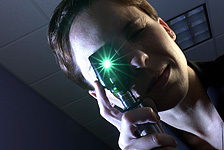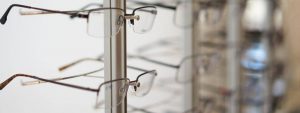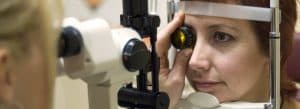Diabetes can have a devastating effect on your entire body, including your eyes.
Here are our top 8 frequently asked questions about how diabetes can affect your eyes.
Q1: What is diabetes?
Diabetes is a disease which causes your body to be unable to produce or properly process the hormone insulin, which is responsible for regulating the amount of sugar (glucose) in your blood.
High blood sugar levels can cause damage to organs and blood vessels throughout the body. Diabetes leads to increased risks of stroke, heart attack and damage to the kidneys, eyes and gums and nerves.
There are two types of diabetes:
Type 1 diabetes: usually affects children, teens and young adults. It is an autoimmune disorder in which the body’s pancreas is unable to produce insulin.
Type 1 diabetics must take insulin every day to survive.
Type 2 diabetics: are able to produce insulin, their bodies are not able to properly process it.
This can cause dangerous spikes and drops in blood sugar levels that can cause feelings of weakness, nausea and dizziness.
Type 2 diabetes rarely affects children, as it is mostly diagnosed in adulthood.
Q2: Is there a way to prevent diabetes?
This depends on the type of diabetes.
Type 1 diabetes is a rare form of diabetes, affecting only 5%-10% of diabetics. Symptoms develop fairly early in life due to a DNA or genetic cause, and there is no known method of prevention.
Type 2 diabetes is the most common form of diabetes, affecting between 90% and 95% of diabetics. It develops over many years and can be prevented or slowed with the right medications, diet, weight maintenance and exercise.
Q3: Can diabetes cause vision loss?
Yes.
Diabetics are at a high risk of developing a range of sight-threatening eye conditions and even blindness.
Diabetic retinopathy is the most frequent condition that many diabetics develop, which occurs due to damage to the tiny fragile blood vessels in the back of the eyes.
A January 2004 article in Diabetes Care, a publication of the American Diabetes Association, stated that nearly all type 1 diabetics in the study, and upwards of 60% of type 2 diabetics in the study developed diabetic retinopathy within the first 20 years after their diabetes diagnosis.
This condition can lead to permanent total or partial vision loss without proper care.
Diabetics are also significantly more likely to develop sight-threatening conditions such as macular edema, cataracts and glaucoma.
Q4: What does a diabetic eye exam include?
Annual eye exams are important for everyone. However, because of the dangers posed by diabetes to a person’s sight, it is especially important for diabetics to have regularly scheduled eye exams, sometimes more than once a year.
During a diabetic eye exam, your eye doctor will perform a number of tests to better detect the signs of diabetic retinopathy and related eye conditions.
Here are the tests included in a diabetic eye exam:
1. Dilated pupil exam
In order to get a wider view of the inside of your eye, in particular the retina, your eye doctor may use drops to dilate your eyes. They will then use a device called a slit lamp to take a look for any possible damage caused by eye conditions linked to diabetes.
2. Digital retinal exam
This is a non-invasive process in which your eye doctor uses imaging technology to produce a hi-resolution color image of the back of your eye. These images will include your optic nerve, blood vessels and retina.
These images are kept on file digitally, so that at each subsequent diabetic eye exam, your eye doctor can take similar images and compare them to the ones before. This allows the eye doctor to easily detect changes over time that might indicate damage or significant changes, suggesting eye disease.
3. Optical coherence tomography (OCT)
Your eye doctor may also perform an optical coherence tomography (OCT) scan to achieve a more in-depth view of your retina and optic nerve.
This scan uses a non-radioactive laser to produce a 3 dimensional color-coded, cross-sectional image of the back of your eye, allowing your eye doctor a layer-by-layer view of the retina and optic nerve.
The scan will help your doctor to examine the thickness of your retina, as well as any abnormalities in your optic nerve that may be of concern.
4. Fluorescein angiography
For a detailed view of any leakage from your retinal blood vessels your eye doctor may refer you to an eye surgeon to perform a test called fluorescein angiography.
For this test the ophthalmologist will inject a bright yellow dye into a blood vein to reveal any changes in the structure and function of these blood vessels that may indicate the presence of diabetic retinopathy.
SEE RELATED: Diagnosed With Diabetes? Seeing Your Eye Doctor Is Essential
If you have diabetes, ensure your eye doctor is part of your medical team and schedule frequent eye exams.
Q5: Can diabetes cause blurry vision?
Yes.
Unfortunately, high blood sugar is a common occurrence in people with diabetes. This high blood sugar can cause a bulging of the focusing lens in the eye, which results in blurry vision.
The lens will return back to its original shape once your blood sugar has been brought down to within a normal range. This is a short-term event, where the vision returns to normal once the blood sugar level returns to normal level.
However, if the blood sugar levels stay high, the vision will remain out of focus. After this, it can take up to 3 months for your vision to return to normal.
Q6: What is diabetic retinopathy?
Diabetic retinopathy is an eye condition in which long periods of high blood sugar begin to wear on the blood vessels in the retinal layer of your eyes, causing them to begin leaking.
Diabetic retinopathy affects over 8 million Americans, most are aged 40 and older.
The retina is the nerve layer at the back of the eye that sends all the light signals from the eye to the brain. Any damage to the retina results in vision loss as the leakage results in death of these nerve cells as they are unable to receive enough oxygen.
A more dangerous stage of diabetic retinopathy occurs when, in order to compensate for the blood being lost from the damaged blood vessels, the eye begins to create new retinal blood vessels. These new vessels are very fragile eventually begin to leak causing swelling and eventually scarring of the retina
Left untreated, diabetic retinal damage will leave a person with total loss of vision and blindness.
Q7: Can diabetes cause glaucoma?
Yes.
Glaucoma is a group of eye conditions characterized by damage to the optic nerve caused by elevated inner eye pressure. The increased eye pressure is caused by poor outflow of fluids from the eye, raising the intraocular pressure pressure (IOP).
Untreated glaucoma can cause ‘Tunnel Vision’ and total functional blindness.
Diabetes can sometimes cause a rare form of glaucoma known as neovascular glaucoma.
This condition occurs when the extra blood vessels produced as a result of blood vessel damage begin to grow into the iris, blocking outflow of fluids from the eye and raising inner eye pressure.
Glaucoma often does not have any symptoms until after enough damage has been done to harm your vision irreparably.
Q8: Does diabetes increase the risk of cataracts?
Yes.
Cataracts are a common part of aging, as protein begins to build up in the eye and solidify, causing clouding of the lens. This can cause blurry vision and, if untreated, total loss of vision in the affected eye.
According to a January 2008 article in the Journal of Ophthalmic and Vision Research, diabetics are two to five times more likely overall to develop cataracts than people who don’t have diabetes, and as much as 25 times higher in those under 40 years old.
LEARN MORE: Guide to Eye Conditions
If you have diabetes, schedule an appointment with your eye doctor to ensure the best chance of maintaining good eye health and clear vision.
We hope these 8 frequently asked questions about diabetes and your eyes have helped.
If you have diabetes, your eye doctor is an essential part of your medical team.










